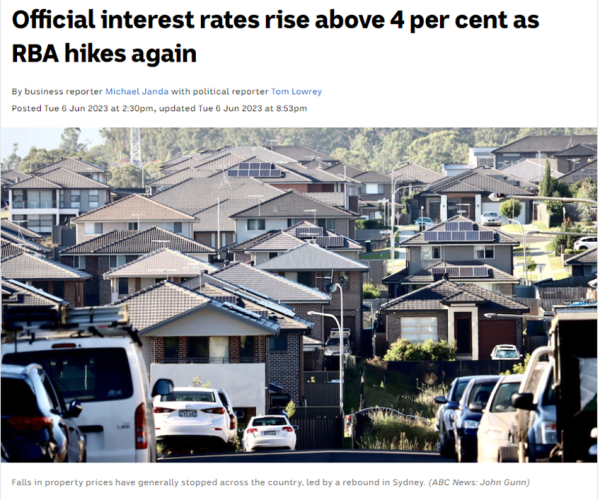If you would like to receive weekly updates like this, sign up here.
This week we are in Australia. This was an example of a typical prominent headline from last week.

Source – ABC News
Is there anything more topical in the country right now than this? Feel free to correct me if you can think of something else.
Yes, that’s right, our dear cousins in the Reserve Bank of Australia (RBA) have decided, after a 1 month pause, to again lift interest rates – its official cash rate – above 4%.
Was it something we said, do you think?
Cue an avalanche of emotion and outpouring of invective towards the RBA Governor.
If there’s one thing I took away from reading PSE director Philip J Anderson’s seminal work The Secret Life of Real Estate and Banking it is this.
Central bankers across the globe held rates too low for too long, and when the inevitable necessity of raising them occurs, raise them too high too quickly.
Every single 18.6-year Real Estate Cycle since World War 2 has seen this, with each subsequent cycle seemingly encouraging even more brazen and outlandish uses of this arcane mechanism, interest rates, to steer the economy.
And so, we come to today, with the RBA seemingly intent on raising until they break something substantial. How do you think they are faring with that?
I know many people are being seriously hurt financially by the decisions these bureaucrats are making. This is the cause of all the emotion and mudslinging.
But at the same time, it’s not helpful.
So today, I’ve decided to dedicate today’s newsletter to examining the truth of what’s happening in Australia. Because the truth is far more nuanced than you’d imagine.
It isn’t ALL the RBA’s fault. In fact, outside factors that aren’t receiving anywhere near the same attention are to some degree forcing the RBA to act.
We will examine some of these factors. Why they are important to the current situation, and most crucially for you, apply our real estate cycle knowledge to help you understand what you “should” be doing about this.
Now is the time to be looking at this.
Let’s start.
Let one third flourish, the other two thirds’ flounder.
It’s very useful to have some sort of benchmark to assess where we are economically. I think the US is as good as any to review.
Seeing as it leads the world into and out of every real estate cycle.
But also, for that very reason, give us in Australia some idea of what we here ‘should’ expect to see more broadly in 6-12 months’ time. Occasionally, I do get pushback for my focus on the US from my Australian readers.
“We don’t care about the US; we want to know what’s going to happen here in Australia!”
Fair. My response generally is: “what, you don’t want a 12-month head start of what you should be doing?” Being that’s precisely what studying the US from an Australian perspective allows you.
But I digress.
So, what’s happening economically speaking in the US? Non-farm payroll jobs jumped over 300K. That’s strong. But the unemployment rate also rose, jumping 440K to 6.1 million, or a jump from 3.4% to 3.7%.
Annualized wage growth rose only 0.3%, taking the year-to-date total to 4.3%. It’s been falling since mid-2022 where it was over 6%.
There is now an expectation that asking rents may fall in line with falling inflation figures.
Expectations in the market of inflation are now below 3% (2.07%).
Now in English.
A classic case of “bad news is actually good news” moment, the rising unemployment figures is considered ‘good’ because it speaks to the long-awaited effects of the last 12 months’ worth of interest rate rises are working.
Allied with falling real wages means the heat is starting to come out of the economy. This is setting lower market expectations for inflation ahead of the release of the May inflation (CPI) figures.
The odds now are above 50% that the US Fed will elect to pause further interest rate rises for at least a month or so.
We will know for sure soon, next week the US Fed meets to decide its next interest rate direction.
But I will say this: it’s early days but there are signs now in the US that rate rises are having the desired effect. And so, overall, that’s good news.

Maybe it’s easier if I give you some darts to throw at a dartboard that lists “falling savings rates, rising minimum wages, record immigration levels, interest owed on purchases etc.”
There’s an awful lot happening on the ground here, and it’s plainly wrong to place the blame squarely on the shoulders of the RBA.
Is it their fault that immigration levels went straight to ‘ludicrous speed’ last year at a time where there’s not enough shelter to provide for them? I think you can thank the current Labor Government for that.
In fact, it’s the only reason why our GDP figures this year are positive.
Nor is it the RBA’s fault the Fair Work Commission (FWC) decided to announce last week a raise in the minimum wage. A 5.75% increase. Now, I don’t know for sure, but I’m certain there’s no such thing as a red hotline phone in either the office of the FWC or RBA.
You simply couldn’t have timed the release of this wage rise any worse! Couldn’t they both have, you know, perhaps discussed these changes with each other first?
Anyway, this stands in stark contrast to the situation for wages in the US.
But here is what has escaped the RBA’s, most likely everyone else’s too, attention and focus.
Australia has been broken into thirds. One third are renters, one third are mortgage holders and one third own their home outright. In effect, one of those groups care not what the RBA does with interest rates, while the other two are currently badly affected by them.
So, lets expand on this, I think it’s not controversial to say that it’s the youngest cohorts who rent (and make up most low-income workers) and for whom the recent minimum wage increase is aimed at.
Then most full-time workers hold most mortgages, and finally those retired outright owned their own homes (and probably most investment properties the first cohort rent). The last dozen rate rises have impacted each very differently and speak to just how blunt an instrument interest rates are.
But it’s the RBA’s desired outcomes which are creating the most pain here.
It’s retirees that are the most insulated from inflation due to their outright home ownership and indexed for inflation pensions. Yes, they will find times tough to some degree now, but nowhere to the extent of the remaining two-thirds.
Which means raising rates to fight high inflation effectively does not work!
Can you see that they are doing the opposite? They’ve created wage inflation (see the minimum wage rise) and are creating land price inflation (rising house prices) to name two.
YES! I said it. Land prices rise, not fall, during a sustained period of interest rate rises.
Those that have, continue to, and arguably always will, scream to the rooftops that the current inflation projections will see a catastrophic crash in our housing market…are wrong.
Therefore, the desired outcome (bring down inflation to this mythical target band of 2%) cannot be attained using the current tool (interest rates). The tool, as it were, isn’t adequate for the job.
So, what is an adequate tool?
We are closer to the end than the beginning.
It defies belief the RBA can’t see this. How you can hurt two thirds of the population to satisfy the remaining third isn’t a sustainable policy decision.
And yet that’s precisely what’s happening today.
It can’t go on this way. But it gets worse. Not only is the wrong tool for the job being deployed, but the data underpinning the decisions made isn’t all it’s cracked up to be either.
Another next-to-useless tool, the current Consumer Price Index (CPI) and its magical ‘basket’ of goods is distorting the figures it produces. Garbage in = garbage out.
The RBA quoted the April CPI data as part of the reason for its latest hike. I argue it would have been more appropriate to use the June quarterly CPI figures for a more substantial data set.
Anyway, it’s neither here nor there. The reason why is because of what constitutes that ‘basket’.
Aprils CPI data showed a 6.8% increase in inflation year ending April 2023. However, if you remove the essentials (those needed to sustain a basic standard of living) the annual inflation rate falls below 6.5%! It’s crazy, I can literally make these numbers show whatever I want by simply adding or removing items.
Plus note annual rent inflation is not included!
So, the RBA would have you believe that continued discretionary spending is driving these higher numbers.
But is that really the case?
Here’s a selection of Australian Bureau of Statistics (ABS) inflation data that produce that April CPI data number.
Electricity rose by 15.2%, diary 14.5%, general food 11.7% and bread and cereals 11.4%. Is this the type of thing you spend your money on for the sake of it? Or do they fit more into the “need these things to live!” bracket.
Consumer spending isn’t to blame here. It’s not discretionary – it’s the basics! And as we know, some Australians find it easier to meet these basic costs than others.
How do we fix this mess? How about we change the tool being used? What if we take away all income tax and replace it with a broad-based land tax?
One that takes 90% or more of land’s earnings and then redistributed this to the citizens of this country. Speculation driving up land prices – removed.
Keep all of what you earn – much easier to pay for the basics you and your family need.
But I digress. We both know this won’t be happening anytime soon. Here’s something practical though that we can do, right now.
Every person who applies for a mortgage will be assessed via the Australian Prudential Regulatory Authority’s (APRA) 3% mortgage serviceability buffer. This is included on top of the pre-agreed interest rate of the mortgage sought to determine how sensitive the borrower is to future interest rates.
Those who can prove they can, get their application accepted. Those that can’t don’t. Simple as that.
Now, you may have joined many thousands in trying to either secure a new mortgage or refinance existing ones.
Well, for those trying to refinance, the same 3% buffer is applied to your loan. Recall however basic mortgage rates have risen dramatically from when you were likely to have applied for it originally.
How stupid! Why on earth would you need to sit through that again when you’ve already done it on the original loan and passed!
It’s the equivalent of you having to resit your driving exam every time you renew your driver’s licence.
So, you want to make a legitimate difference, then remove or drop dramatically this buffer. There, a simple and very easy to implement solution. Again though, you willing to hold your breath waiting?
So, what do you do?
I know what to do. And if you study the history of the 18.6-year Real Estate Cycle, it will become very clear what’s to come. However, if you’re new to this cycle research then you need to start here with a membership to the Boom Bust Bulletin.
To understand what happens next and how to take advantage of it you need to understand the cycle and its history. So, please give me the opportunity to take you in depth into the cycle.
Learn about the over 200-year history of the 18.6-year Real Estate Cycle and why even today it continues to repeat like clockwork.
It will teach you how to decipher the news that we get bombarded with every day to focus solely on what truly matters.
You will be able to navigate the hype, ignore the negativity and noise. You will focus on the fundamental forces that drive the economy, the science of the economic rent and the timing inherent in the real estate cycle.
This knowledge is all you need to succeed.
Believe it or not, all you need to do to know where Australia is heading is watch the US land market. As I said, Australia is generally 12-18 months behind the US in terms of how we transit our own real estate cycle.
Besides, there “is” good news for the Australian economy. Tourism is booming, and certain key commodity resources are in high demand, helping our balance of trade.
But the true turning moment for us will be, by and large, like what occurred in the US. Peak inflation there was back in June 2022. And most in the know agree that high inflation was supply side driven. US inflation as stated earlier is in the 3-4% band.
This has led the US Fed to strongly consider a pause in rises for at least a few months later this year. The heat is coming out of its economy, most loans owned on housing are well in the positive and forced selling is nowhere to be seen.
Talk in the US is for rates to fall now early in 2024.
So, this is Australia’s future folks. We are today much closer to the end of this current cycle than the beginning.
As much as I’ve railed against the use of interest rates and the various government policies that have heaped on pain to so many, ironic as it may seem, these rate rises will eventually work.
Yes, it could have been so less painful and dramatic than it has been these last 12 months or so.
And there’s likely a bit more pain to come.
But like the US, we will see rates paused, and I’m 100% certain next year in 2024 rates will fall. In fact, they may fall more than a full percent.
Which will kick start the next leg up for our property markets. And our banks will be ready too.
We await now for those key turning points in the US land markets to know when it’s likely to occur.
What an incredible advantage knowledge of the real estate cycle can give you.
This is not a concept you’ll be taught anywhere else. And that’s how the BBB can help.
As a Boom Bust Bulletin member you will receive 12 monthly editions a year detailing all the key turning points of the cycle, a deep dive into the most important markets across the globe and ways that you can personally benefit from this knowledge.
All derived from our unique and proprietary research – which you’ll not find anywhere else.
Plus, you’ll receive exclusive invites to BBB member-only webinars when we run them.
All this for just US $4 a month, less than a takeaway coffee.
Ok, time for me to sit the kids down and explain to them what they’ve cost me these last 19 years.
Best wishes,

Darren J Wilson
and your Property Sharemarket Economics Team
P.S. – If you would like to receive weekly updates like this, sign up here.
P.P.S – Find us on Twitter here and go to our Facebook page here.
This content is not personal or general advice. If you are in doubt as to how to apply or even should be applying the content in this document to your own personal situation, we recommend you seek professional financial advice. Feel free to forward this email to any other person whom you think should read it.



